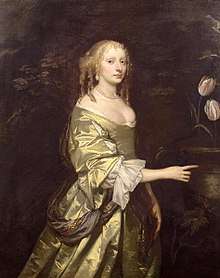Elizabeth Wilbraham
Elizabeth, Lady Wilbraham (14 February 1632 – 27 July 1705), née Mytton, was a member of the English aristocracy, who traditionally has been identified as an important architectural patron. Historian John Millar posited her to be the first known woman architect, whose work frequently may have been attributed to men. In addition to a dozen family residences and a larger number of churches, as many as 400 buildings may have been designed by her.
Elizabeth Mytton Wilbraham | |
|---|---|
 Elizabeth Lady Wilbraham - by Sir Peter Lely | |
| Born | February 14, 1632 Weston under Lizard, Staffordshire, England |
| Died | July 27, 1705 (aged 73) Weston under Lizard, Staffordshire, England |
| Occupation | Architect |
| Spouse(s) | Sir Thomas Wilbraham, 2nd Baronet |
Early years
Elizabeth Mytton was born into a wealthy family and, aged 19, married Thomas Wilbraham,[1] heir to the Baronetcy of Wilbraham. They went on honeymoon together, travelling throughout Europe. She made this an opportunity to take an extended architectural study tour.
In the Netherlands Elizabeth Wilbraham met architect Pieter Post,[1] creator of the Dutch baroque style of architecture. She studied the works of Palladio in Veneto, Italy and the Stadtresidenz at Landshut, Germany.[2]
Personal life
Little is known about Lady Wilbraham's private life, but private letters were discovered and passed to the Staffordshire Record Office in 2008. These showed Lady Wilbraham's search for suitable husbands for her daughters, Grace and Margaret. According to the marketing executive of the Weston Park Foundation, "The letters explain the importance of a suitable match within the aristocracy of the day. She was certainly a very strong lady and knew what she wanted and how to get it".[3]
First known woman architect
A 2012 book by historian John Millar claims that Elizabeth Wilbraham is the first known woman architect.[1] Millar says this follows more than 50 years of research into the subject.[2] In 2007 the owners of the stately home, Wotton House, organised a conference to investigate who was the original architect of the building. The conference generated at least two follow-up papers: in 2010 Sir Howard Colvin proposed that John Fitch may have been the original architect, and later the same year, Millar, noting Colvin's paper, proposed Lady Wilbraham as an alternative.[4][5] During the seventeenth century it was impossible for a woman to pursue a profession and Lady Wilbraham is said to have used male executant architects to supervise construction in her place.[1] She is believed to have designed more than a dozen houses for her family and, because of the inclusion of distinctive and unusual design details, has been put forward by Millar as the designer of 18 London churches (officially attributed to Christopher Wren).[1] Because Wren came late to architecture, Elizabeth Wilbraham has been suggested by Millar as his most likely tutor.[1]
As many as 400 buildings have been suggested by Millar as possible works of Elizabeth Wilbraham. They all generally show similarities with Italian or Dutch architecture.[2] Wilbraham owned a 1663 edition of Palladio's book I Quattro Libri (volume I) and she heavily annotated it.[2] In the authoritative and encyclopaedic Biographical Dictionary of British Architects 1600-1840 (4th Edn; 2008) by Sir Howard Colvin, however, she is mentioned only once. That notation is as a patroness of architecture. In her dissertation from 2002, Canadian historian, Cynthia Hammond mentions the “awkward designations” given to Lady Wilbraham by Nikolaus Pevsner. She notes his lack in saying “by Wilbraham” to denote an eroding of Wilbraham’s authorship when discussing Weston Park.[6]
Notable projects
- Weston Park, Staffordshire (1671)[7] - sources such as Historic England attribute the design to Elizabeth Wilbraham, but others, such as the Weston Park Foundation, press the claims of William Taylor.[lower-alpha 1][8]
- St Andrew's Church, Weston-under-Lizard - the estate church for Weston Park. Pevsner describes the church as "an enterprise of Lady Wilbraham...[of] 1700-1".[9]
- Wotton House, Buckinghamshire (rebuilt 1704-1714) - architect unknown, but Elizabeth Wilbraham or John Fitch have been put forward.[2]
Footnotes
- In support of William Taylor being the architect, the Weston Park Foundation notes the architectural similarities between the house and the Church of the Holy Trinity at Minsterley, 30 miles away across the county border in Shropshire, which is known to be by Taylor.[8]
References
- Jay Merrick Elizabeth Wilbraham, the first lady of architecture, The Independent, 16 February 2011. Retrieved 2011-12-06.
- John Millar The first woman architect, The Architects' Journal, 11 November 2010. Retrieved 2011-12-06.
- Rare letters of Weston Park aristocrat donated to public records, The Birmingham Post, 26 November 2008 (archived on thefreelibrary.com). Retrieved 2012-02-02.
- Colvin's paper was published in the 2010 Georgian Group Journal (Millar 2010)
- Millar 2010.
- Hammond, Cynthia Imogen. Wings, Gender and Architecture: Remembering Bath England. 2002. Concordia University, PhD dissertation.
- Historic England. "Weston Hall and service wings to north and east (Grade I) (1039264)". National Heritage List for England. Retrieved 24 May 2020.
- "The History of Weston Park". The Weston Park Foundation. Retrieved 24 May 2020.
- Pevsner 1974, pp. 306-307.
Sources
- Millar, John (11 November 2010). "The first woman architect". The Architects' Journal.CS1 maint: ref=harv (link)
- Pevsner, Nikolaus (1974). Staffordshire. Buildings of England. London, UK: Penguin Books. ISBN 0-14-071046-9.
See also
Further reading
- Anne Laurence, "Women Using Building in Seventeenth-Century England: A Question of Sources?" Transactions of the Royal Historical Society (2003)
- Eva Alvarez and Carlos Gomez. “The Invisible Women: How Female Architects were Erased from History.” Architectural Review, 2017
- Eve M. Kahn, “Maybe a Lady Taught Christopher Wren.” The New York Times, 2012